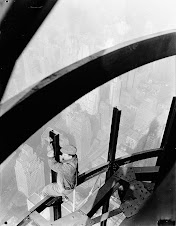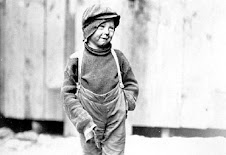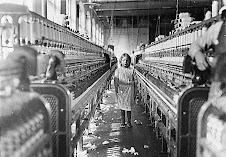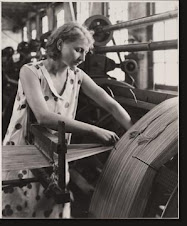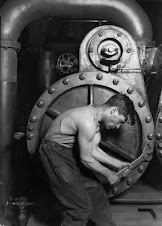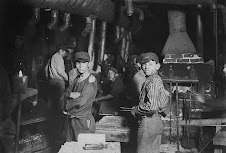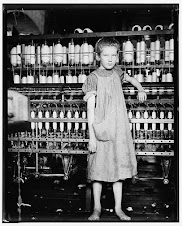Interview with Lewis Hine
Interviewer - What events in your early life made you get interested in the arts?
Lewis Hine - When I was eighteen years old, my father died and I took the responsibility of supporting my family by taking a series of oddball jobs. My first job was at a furniture upholstery factory where I worked thirteen hours a day. I worked in clothing department stores, I sold water filters, and eventually worked as a janitor in a bank, “where after several years, I worked up as far as a supervising sweeper (Hine, xxiv).” I studied stenography, drawing, and sculpture and took some university extension courses where I met Frank Manny, the principal of the State Normal School. Manny convinced me to go to his school and after graduating I spent two years at the University of Chicago studying to become a teacher. When Manny became superintendent of the Ethical Culture School in New York, he brought me and several other teachers with him to work at the school.
I taught nature study and geography to my students and constantly battled with my dignity in my effort to entertain them and keep them attentive while I taught such dry subjects. After I had been a teacher for Manny for a few years, he decided that we needed to start “visualizing school activities with the camera (Hine, xxiv).” Imagine my utmost surprise when he assigned me, a man who had never even touched a camera before, the duty of becoming the school photographer and taking pictures of the school activities. Well, apparently my pictures were pretty darn good because Manny wanted to start using them as an educational tool. We often traveled to Ellis Island to take pictures of the incoming immigrants so that the E.C.S. pupils would “have the same regard for contemporary immigrants as they have for the Pilgrims who landed at Plymouth Rock (Hine, xxv).” I never even considered the fact that photography would be my métier. I honestly thought that I would be a teacher all my life.
Interviewer - What was the world of art like in your particular art field when you entered it?
Lewis Hine - In my time, the joining of storytelling with photography was so repugnant to the public that it seemed almost blasphemous. “High art” photographers such as Alfred Stieglitz considered my kind of work to be distasteful and ridiculous. I worked in a social documentary style and wrote all the captions for my photos. I would interview my subjects with questions about their age, height, jobs, years of employment, family situation, illnesses, and schooling. I used the captions with the pictures to tell a story. Not just any story though, their specific stories.
I, unlike most freelance photographers, demanded complete control over all my photographs. I was to keep the negatives, I was to say where they could go and could not go, and I was to pick the order in which they were drawn out. This was why I was not hired very often and had quite a bit of a financial problem. I was the very definition of a starving artist. I was considered shrewd and foolish for losing work because of my high demands, but even the thought of severe poverty did not stop me. “The finances are very decidedly secondary to the work (Hine, 6).” My photographs were meant to reveal the harsh truth of the lives of everyday laborers and I would see to it that that’s exactly how they were perceived.
Interviewer - How did the major cultural, economic, and political situations of the time impact your work?
Lewis Hine - I worked during the Industrial Revolution, so that’s what a large portion of my work was based on. As more and more factories and mines opened, more and more people were sucked in to work. “I have had, all along as you know, a conviction, that my own demonstration of the value of the photographic appeal, can find its real fruition best if it helps the workers realize that they themselves can use it as a lever even though it not the mainspring to the works (Hine, 6).” “My child labor photos….set the authorities to work to see if such things can be possible. They tried to get around them by crying ‘fake,’ but therein lies the value of data and a witness. My ‘sociological horizon’ broadens daily (Hine, 7).”
I like to call my photographs detective work, revealing the disturbing truth of the life of everyday workers. I had a hard time getting people to listen though. The public was unwilling to accept that terrible conditions of the workers and the management of the places I photographed at become increasingly hostile and violent. I would send my work to several different publication agencies and worked as a freelance photographer for the National Child Labor Committee so that I could help them in their goal to enact laws prohibiting child labor. I remember once telling an audience of watchers that “Perhaps you are weary of child labor pictures. Well, so are the rest of us. But we propose to make you and the whole country so sick and tired of the whole business that when the time for action comes, child labor pictures will be records of the past (Hine, Spartacus).”
Interviewer - What role did mentors play in helping you develop the interests and talents you have as an artist?
Lewis Hine - I would have to say that Frank Manny was the most mentor-like person I’ve ever had. I never would have even picked up a camera if it weren’t for him. Frank was a good friend of mine and really helped me make some good decisions in life. He was the one who convinced me to go to school and college. Frank was the one to get me a teaching job at the Ethical Culture School. Frank assigned me as the school photographer and really liked my work, encouraging me to do more. He even traveled with me to Ellis Island to photograph the incoming immigrants.
When I started to attend the Columbia School for Social Work, I met Arthur Kellogg, who introduced me to his brother, Paul Kellogg. Arthur was the one that suggested that I become a sociological photographer, a person who photographs child workers, in the first place. Paul and I worked together for thirty-five years, photographing not only child laborers, but also men and women at work and refugees. When Paul began to use my pictures as examples for his editorial reforms, his reputation grew exponentially. Paul was asked to direct The Pittsburg Survey, the first extensive examination of social conditions in an American city. With the success of the survey, Paul was promoted to an editor of the newly appointed magazine, The Survey. I was hired as its first staff photographer and me and Paul worked together for every major child exposé that I ever composed.
Interviewer - What were your major accomplishments and the methods you used in your art?
Lewis Hine - I am proud to say that the work I did was very influential to the effort in ending child labor. Owen Lovejoy, a wonderful man and the Chairman of the National Child Labor Committee at that time, wrote that: “the work Hine did for this reform was more responsible than all other efforts in bringing the need to public attention (Hine, Spartacus).” If something like that doesn’t boost your ego, I don’t know what will! I do remember him chuckling at some of the stories I would tell him about my work though. I would get all fancied up and go to all the different work places to take my pictures of the worn down workers. It was an extremely rare occasion when the management willingly let me inside. I assumed several different roles - such as a postcard salesman, an industrial photographer making a record of the machinery, a fire inspector, and a Bible salesman - just to gain entrance. If that didn’t work, I would stand outside the cannery, mine, sweatshop, farm, or factory with my fifty pounds of camera equipment and take some photographs there.
I traveled all around the country to get different points of view from different worksites. I traveled as much as 30,000 miles a year with my wife, Sara, to work on my social documentary photos. My photographs regularly appeared in stereopticon slide shows, newspapers, N.C.L.C. and several other progressive publications, and exhibitions, always under my control of course. When the N.C.L.C. promoted me to director of the exhibits department, I was well on to my way to being considered the most successful photographer of social welfare work in the country. However, “I have to sit down, every so often, and give myself a spiritual antiseptic… Sometimes I still have grave doubts about it all. There is a need for this kind of detective work and it is a good cause, but it is not always easy to be sure that it all is necessary (Hine, 9).”
Interviewer - What were the key opportunities you had that led to turning points in your life and art?
Lewis Hine - When the Jury for the Art Directors Club Exhibition of Advertising Arts gave me the medal for photographs in April of 1924, I was suddenly given a lot more recognition. I was unexpectedly given multiple job opportunities and my income and reputation as an artist rose quite a bit. I was offered a role in photographing the construction of the Empire State Building, an assignment for Shelton Looms, and several other time-consuming jobs interpreting Life & Labor for Social Welfare Labor Organizations. I photographed the progress of the rising Empire State Building from start to finish. I experienced quite a few extra thrills while working on that site, mainly because I was swung out into a hanging box suspended in the air a quarter mile from the ground on the hundredth floor to get some shots of the tower. I was quite proud of myself, having achieved a record of being at the highest point reached on a man-made structure at that time.
When I was assigned to work on the Shelton Looms projects, I met the president, Sidney Blumenthal, and it probably “was one of the most valuable and productive associations with private industry that [I] developed (Hine, 51).” I photographed all the different views of the manufacture of the finest fabrics at the Shelton Looms. I created a portfolio of twenty photographs from that experience and published it that very same year. That publication opened doors to numerous museum curators and Dr. Arthur Morgan, the director at that time of the Work Progress Administration and the Tennessee Valley Authority. I came to support company provided disability compensation, pensions, and life insurance. For me, it was an artistic and commercial success.
Interviewer - What personal choices did you make to become successful?
Lewis Hine - After I had been working with the National Child Labor Committee for around 12 years, they suddenly decided to reduce my salary and that just added onto my growing ambivalence about the agency’s tactics. So, I left the N.C.L.C. and talked to Arthur Kellogg about working with the American Red Cross for World War I. I was given the position as a captain and worked for renowned social worker Lt. Col. Homer Folks. I chronicled the public health activities in Paris and traveled northern and southwestern France to photograph refugees. I traveled through Italy, Serbia, and Greece in a two-month time span and photographed and interviewed the locals. I sent several photo stories about reconstruction programs and refugees to The Survey throughout my time in the American Red Cross.
When I came back to America, I chose to change my view point in my photographs. I decided to alter my photographic program from “negative to positive documentation (Hine, 19).” Using the term “Work Portraits (Hine, 19),” I started to focus on depicting the industry from the worker’s point of view. A series of photographs I called the “Human Side of The System (Hine, 20)” was what I considered to be one of the very best things I had ever done. “The industrial lead I [had] been following [was] tremendous and virgin soil (Hine, 20).” Although I had a real hard time finding any corporate assignments, I was completely unwavering in my resolve, for I thought the idea was one of my finest.
Interviewer - What hardships or roadblocks did you have to overcome in order to become successful?
Lewis Hine - When I was 58, I was given a month-long assignment at Dr. Arthur Morgan’s Tennessee Valley Authority project. I was to photograph the Wilson and Muscle Shoals dam site. I was paid $1,000 while working on this project, but I have to say that it was not worth it at all. Morgan was completely unable to understand the value of my work. He used my photographs to duplicate charts and blueprints instead of using it to stimulate the public interest like it was intended. I was unbelievably frustrated with him and he only got worse. He continually reproduced my work without any bylines or credit. Because of Morgan’s complete ignorance and indifference, I ended all ties with the agency and wanted nothing more to do with them.
I also had several injuries throughout the years. Due to the gymnastics I tended to resort to in order to get a good angle on something, I often fell. I remember one particular year when I broke my leg. It was a bad break and I couldn’t carry my camera equipment around for quite a while. Because of that broken leg, I couldn’t take my photographs. Without my photographs, I had no means of income. I was supposed to make sure I was completely safe and sturdy when I took my pictures so that those accidents would cease, but I guess I would get too caught up in the moment of the photograph to really care about my safety.
Interviewer - What kind of limitations did you run into as both an artist and a person?
Lewis Hine - Like any other normal human being, I’m not immune to the feelings of sadness. They bring me down and tear me up just as they would anyone else. When my wife died from pneumonia on Christmas morning, I was torn with grief. My son, Corydon, and I had to learn to get on without her and finish all the things we started together. I could barley stand to write the letters to our friends, telling them of her sudden passing. It took all I could to go back to work and continue photographing.
To make all matters worse, that very same year our house was foreclosed. The money I made from photography was never quite enough. We continued to live there on a monthly basis, but it was no longer ours. It then belonged to Federal Home Loan Bank Board and they had a hell of a time antagonizing me with their letters. But no matter what complications rose up, I continued on with my work. I persisted to take photographs, to interview workers, to send my pictures to different publication agencies, and to raise my status as a photographer.
Interviewer - What personal stories best illustrate how you became successful in the arts?
Lewis Hine - When I worked for the Empire State Building, very few of my photos were actually used for the commercial purposes I was hired for. Most of my pictures were worker-oriented and did little to show the majestic quality of the building. I had reverted to my normal view and quickly focused on the workers, forgetting that for this job I was supposed to be focused on the actual building. I was not deterred though from the minimal use of my work and used them in my exhibits after sepia-toning and enlarging them into what I think were beautiful pieces of art. It wasn’t every day one got to see a snapshot of a man in cherry-pickers suspended hundreds of feet in the air. I thought that the entire Empire State Building series was quite successful and I thoroughly enjoyed it.
But once again, my stubbornness to relinquish my hold on my negatives and prints caught up with me. I was offered less and less freelance work and most of my recommendations referred to my “artistic temperament (Hine, xxxii).” In fact, a telegram recommending me to the Rural Electrification Administration read: “IS TRUE ARTIST TYPE. REQUIRES HANDLING AS SUCH (Hine, xxxii).” “Satisfactory arrangements” were rarely able to be negotiated and I think that quite a few of my employers wanted to strangle me at one point or another. In a time where it was unheard of for a photographer so have rights over their work, I was an unpleasant surprise for my managers. I understood the value of my work and I was not about to have anything stolen from me because it was my art and I was the one that made them beautiful.
Bibliography
Lewis Hine Spartacus. Spartacus Educational. Web. 2 Mar. 2010
http://www.spartacus.
Photo Story Selected Letters and Photographs of Lewis Hine. Washington, D.C: Smithsonian Institution Press, 1992. Print.

